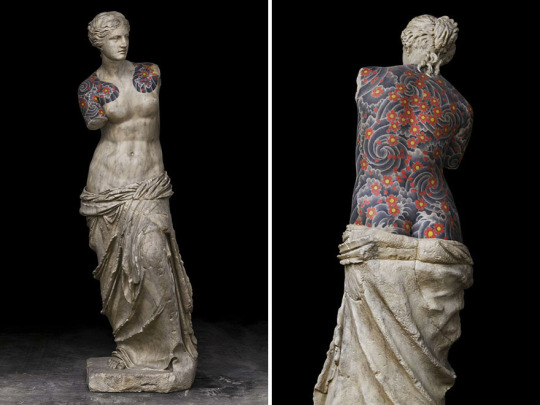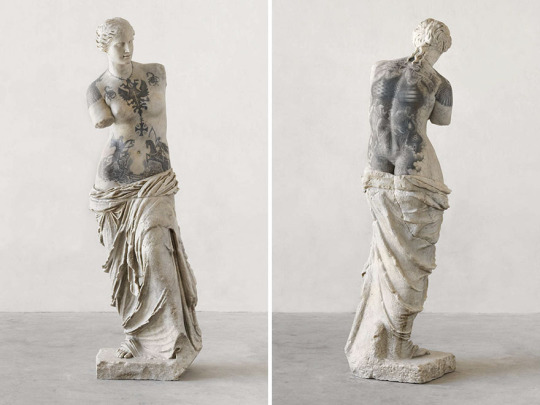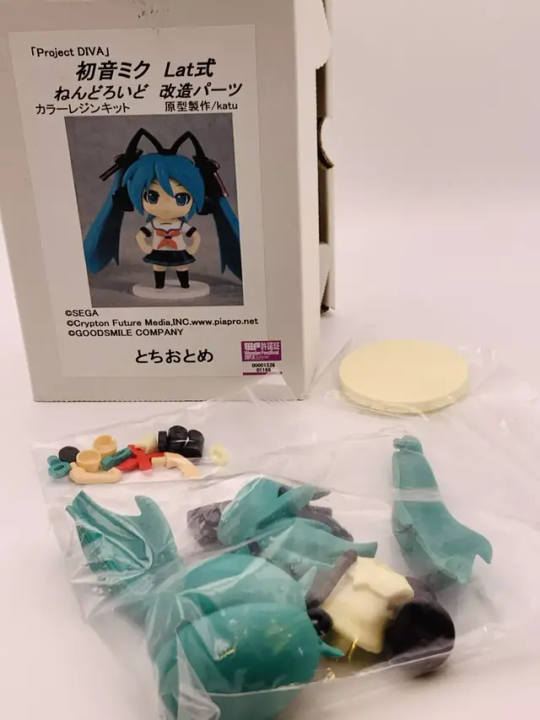#japanese sculptor
Explore tagged Tumblr posts
Text

加藤巍山 (Gizan Katoh) b. 1968, 示現 (Manifestation)
#kato gizan#gizan katoh#加藤 巍山#japanese artist#buddhist sculptor#japanese sculptor#buddhist artist#buddhist art#japanese art#sculpture#buddhist sculpture#japanese sculpture#art#arte#kunst#obra de arte#kunstwerk#20th century art#artwork#1968#示現#manifestation#vision#jigen#katoh gizan#gizan kato
68 notes
·
View notes
Text

Fudo Myo-o, 13th century
#Fudo Myo-o#Fudo Myo#myo-o#Japanese Buddhism#Acala Vidyaraja#Five Bright Kings#Fudo#Ho-ken#Kensaku#Japanese sculptor#asian art#Yamabushi#Joseph and Helen Regenstein Foundation#wisdom king#sculpture
6 notes
·
View notes
Text

Takuro Kuwata (Japanese, b. 1981, lives and works in Tajimi City, Gifu Japan), Untitled, 2024. Porcelain, stone, glaze, pigment, gold, platinum, 44 1/10 × 15 9/10 × 15 9/10 in. | 112 × 40.5 × 40.5 cm. (Source: Kosaku Kanechika Gallery, Tokyo)
#Takuro Kuwata#sculpture#contemporary sculpture#21st century sculpture#cermaic art#Japanese sculpture#Japanese sculptor#Japanese ceramics#Japanese ceramicist
1 note
·
View note
Text

Ruth Asawa posing with her Looped-Wire Sculptures, 1954
7 notes
·
View notes
Text

Eyescream Feb 2015
Great Dinosaur Expo
Masakatsu Shimoda x Shuntaro Tanikawa x Meisa Fujishiro
Dinosaur man, photography and poetry.
Masakatsu Shimoda is a painter who continues to create dinosaurs on canvas as his life's work. Photographer Meisa Fujishiro continues to photograph the dynamic dinosaur-people while waiting anxiously for the parcels he delivers in Okinawa. And poet Shuntaro Tanikawa dedicates poetry to those photographs. The "Dinosaur Mask," a serial project in the fashion culture magazine "HUgE," has finally been published as a book titled "Dinosaur Human." To coincide with the publication, an event will be held at Shibuya Parco Museum. The photos and poems included in the book "Dinosaur Human," as well as dinosaurs created by Masakatsu Shimoda, will all be gathered together. The book "Dinosaur Human" will also be released in advance, and a participation event for visitors is also planned. Come meet the dinosaurs created by these three people in Shibuya.
#my scans#fashion#avantgarde#japanese fashion#2010s fashion#comme des garçons#comme des garcons homme plus#dinosaur#sculptor#sculpture#art
8 notes
·
View notes
Text




Yoshimasa Tsuchiya 🤍
#art#sculpture#animals#animal sculpture#coquette#coquette art#mythical creatures#dragon art#wood carving#artwork#sculptor#japanese art
51 notes
·
View notes
Text


Fabio Viale, 2017 (sculptor)
15 notes
·
View notes
Text

Yuriko Yamaguchi, After Chance, 1988, screenprint on paper, image: 22 1⁄2 x 29 1⁄2 in. (57.2 x 75.0 cm), Smithsonian American Art Museum, Gift of Tom and Judy Brody, 1990.23, © 1988, Yuriko Yamaguchi
2 notes
·
View notes
Text
My First art post on Tumbler. I hope I catch your eyes!

3 notes
·
View notes
Text

(2014), porcelaneous stoneware, 12 7/8 x 20 x 22 1/4 inches. Photo by Richard Goodbody.
Tens of Thousands of Clay Shavings Cloak Hattori Makiko’s Coiled Porcelain Sculptures
Creating one of Hattori Makiko’s twisted porcelain sculptures is an exercise in patience. The Japanese artist makes just a few works a year, each requiring tens of thousands of rolled clay shavings precisely placed on and within the curved forms. Dense with crinkled florets, the unglazed pieces are made from Seto porcelain, a material from Aichi Prefecture in Japan, and can take up to six months to dry.

“Samayou (Wandering)” (2012), porcelaneous stoneware, 11 3/4 x 15 3/4 x 15 3/4 inches. Photo by Richard Goodbody

“Mayu; Cocoon” (2019), unglazed Porcelaneous stoneware, 15 x 9 7/8 inches. Photo by Richard Goodbody

“Kizashi; Sign” (2023), unglazed porcelaneous stoneware 11 3/8 x 15 3/4 inches. Photo by Hayashi Tatsuo
#hattori makiko#artist#art#sculptor#clay shavings#coiled porcelain sculptures#sculptures#japanese artist#seto porcelain#aichi prefecture#japan#richard goodbody#photographer#hayashi tatsuo
1 note
·
View note
Text

Mio Hashimoto ( contemporary Japanese sculptor, b. 1980)
103K notes
·
View notes
Text
Garage Kits and You: A Summary
Garage Kit figures have been brought up here a lot lately and I've gotten quite a few asks about them, so I thought it would be easier for us all to just put all the info into one post ✧(。•̀ᴗ-)✧
They're made in small amounts so finding one specific one can be kind of hard to near impossible.
Please note I've never assembled one myself so this is all taken from second hand sources!
Garage Kits are, as the name suggests, figure kits you can buy to assemble and paint yourself. Some are and some aren't officially licensed, but all are fan-made. Garage kits are not very popular in the West currently, but they're pretty big in Japan.

They're sold in Japanese Live Shows/Festivals or online via the sculptor's sites. They're typically made of casted resin because it's easiest to work with and they come unassembled and unpainted. Westerners can find them on places like Mandrake, Rakuten, Surugaya or reselling on eBay. They can be kind of pricey sometimes though so buyer beware.
Like buying most anime goods, fakes exist. They can be made of cheaper materials that are harder to paint on or assemble, so be cautious when buying them secondhand.
HERE is a link to the MyFigureCollection forum post about buying them
HERE is the r/Animefigures post on buying them
A helpful Anon gave some personal advice on buying and painting them

HERE is an extensive guide by a MyFigureCollection user on what tools they use to put together their kits
That's a basic rundown on garage kits!! If I got anything wrong or need to add anything to the post, please let me know so I can add it/edit it to keep this post as accurate as possible (* ^ ω ^)
92 notes
·
View notes
Text

[Year: 1867 Medium: Albumen silver print from glass negative Artist/creator: Portrait taken of an unknown samurai, by the respected Nagasaki photographer Uchida Kuichi, at his Yokohama studio before he moved to the Asakusa district of Edo (modern Tokyo). Uchida would go on to be the first and only photographer permitted to photograph the Emperor Meiji.]
i love the thought of nations appearing in old photographs and portraits, crossing paths with real photographers, painters and sculptors—and leaving glimpses of themselves throughout history that way. personally, i think kiku always kept long hair—until the pressure to westernise unleashed by the american black ships and the encroachment of other western powers. and so, right on the dawn of the meiji era, i see him deciding to have one final photograph taken before that symbolic haircut that would break with centuries of japanese and wider east asian tradition.
342 notes
·
View notes
Text







Contemporary Japanese master printer Hajime Namiki was born in 1947 in Tokyo. Although originally trained as a sculptor, he began making wood block prints in 1978. He carves his own blocks and prints each work using traditional methods. These beautiful prints are printed on a gold or silver leaf laid over Torinoko paper. Namiki also uses oil-based paints rather than the more common use of watercolors.
Namiki’s most famous and striking subjects are his nature scenes. Fascinated by trees, he has captured their beauty in a modern style using traditional methods. Namiki’s prints were released in strictly limited editions and are numbered in pencil in the margin.
54 notes
·
View notes
Text
thinking about a sigma that was put forth into existence without knowledge of language.
He didn't understand anything anyone said when he was first "born" and had to learn language from short tempered people who only valued his ability to get information. And sure, he learned fast. But he had to.
Fyodor speaks to him in a new language, when he meets him. Sigma struggles to keep up at first, but Fyodor is patient. But he notices that when Fyodor speaks to Nikolai, it isn't in the same language. All this time Fyodor's been prepping Sigma's Japanese, the language he'll use when the time comes while Nikolai learns Fyodor's own native language. It's an intimacy Sigma doesn't want- not from Fyodor or Nikolai, at least- but feels envious of, still.
Studying for the Casino was one of the hardest things he'd ever done, in all honesty. He's extremely good at remembering faces, but assigning a number to everyone? He's not used to that, but in order to communicate with others it's necessary. It's just another way he's different.
He has a habit he keeps a tight lid on to answer with vocalizations rather than words. He'll hum notes instead of answering questions when he's at his most comfortable. And when he's near you, he'd rather get your attention by putting a hand on your shoulder than calling your name.
When his ability is used, it transfers raw images or feelings rather than linguistic information.
It's the truest form of knowledge, and it's Sigma's native language.
So naturally, after everything, Sigma becomes an artist, a musician, a sculptor, anything that transmits emotion in a non-linguistic manner. He learns to love the way that colors and keys and textures can all convey movement in a way that means he can communicate without language.
(Sigma still practices his language skills. He has apps on his phone for flash cards and asks people to teach him their native languages. It's just... something that isn't natural to him, no matter how useful it's proven itself.)
88 notes
·
View notes
Text

HUgE October 2013
dinosaur mask
Title and text: Shuntaro Tanikawa Dinosaur production: Masakatsu Shimoda Photography: Meisa Fujishiro
what you can't see
Something never seen before is coming across the ocean from afar. It's exciting. It makes you feel thrilled. Perhaps it will bring you treasure hidden on a legendary island.
But things that we have never seen before appear in terrifying forms, protruding horns, baring fangs, and making no attempt to hide their claws.
But what's even more frightening is what we can't see even if we try, what lives unseen in the depths of the ocean, what drags our hearts into the darkness where no light can reach.
Shuntaro Tanikawa (Poet) A leading figure in modern Japanese poetry. In addition to his own collection of works, he has also written many picture books and translations.
Masakatsu Shimoda (Painter) He loves travel and people. Since attending the 2011 Dinosaur Expo, he has been devoted to creating dinosaurs.
Meisa Fujishiro (Photographer and Novelist) Currently living in Kitanakagusuku Village, Okinawa Prefecture. A life of migration and permanent residence.
Dinosaur of the Month [Viking Skull]
When I traveled to Tibet, perhaps because of the yak bones I saw everywhere, I dreamed that I had big horns growing on my head. I saw a Viking exhibit at a museum in Iceland. I wonder if the author imagined a terrifying world outside that he had never seen before, when a big man wearing a helmet with big horns on his head came on a ship from across the sea a long time ago? (by Masakatsu Shimoda)
#my scans#fashion#archive fashion#avantgarde#japanese fashion#2010s fashion#comme des garcons homme plus#comme des garçons#sculpture#sculptor#art
0 notes